THE PRESIDENT’S OFFICE
REGIONAL ADMINISTRATIVE AND LOCAL GOVERNMENT
FORM TWO EXAMINATIONS SEPT 2022
NEW NECTA FORMAT
031 PHYSICS
TIME: 2:30 HRS
INSTRUCTIONS
- This paper consists of sections A, B and C with a total of ten(10) questions
- Answer ALL questions in the space(s) provided
- All writings must be in blue or black ink except drawings which must be in pencil
- All communication devices and calculators are not allowed in the examination room
- Write your Examination number at the top right corner of every page.
- Where necessary the following constant may be used
(i) Acceleration due to gravity g=10m/s2
(ii) Density of water = 1g/cm3 or 1000kg/m3
| FOR EXAMINERS’ USE ONLY | ||
| QUESTION NUMBER | SCORE | EXAMINERS INITIALS |
| 1 | ||
| 2 | ||
| 3 | ||
| 4 | ||
| 5 | ||
| 6 | ||
| 7 | ||
| 8 | ||
| 9 | ||
| 10 | ||
| TOTAL | ||
| ENTERER’S INITIALS | ||
| CHECKERS INITIALS | ||
SECTION A (30MARKS)
Answer ALL questions from this section
1. For each of the items (i)- (xx), choose the correct answer among the given alternatives and write its letter besides the item number in the box provided
(i) Force of attraction between molecules of two different substances is called…………
A. cohesion B. adhesion C. capillarity D. surface tension
(ii) A piece of metal has mass of 0.64g and volume of 0.16cm3. What will be its density?
A. 4000kg/m3 B. 0.25kg/m3 C. 3.0kg/m3 D. 4kg/m3
(iii) The minimum pressure exerted by rectangular wooden block of 12kg measuring 4mx 3m x 2m on the bench is
A. 20N/m2 B. 1.5N/m2 C. 10N/m2 D. 0.5N/m2
(iv) The pressure of water at the bottom of a pond 6.5m deep is……
A. 65,000N/m2 B. 6,500N/m2 C. 320N/m2 D. 340N/m2
(v) If the upthrust is greater than the weight of a body then the body
A. floats imperfectly B. floats perfectly C. rises D. sinks
(vi) A body weights 11.8N when totally immersed in a liquid, if the weight of the liquid displaced is 4.2N, the weight of the body in air is………
A. 7.6 N B. 16N C. 2.8N D. 49.56N
(vii) A solid ball is taken from the earth to the moon. On the moon the ball has different….
A. density B. weight C. mass D. volume
(viii) Which of the following devices work with the help of atmospheric pressure?
A. bicycle pump and hydrolysis press. B. flushing tank and syringes
C. lifts pumps and hydrometer D. car brakes and siphon
(ix) A current of 0.4A flows through a resistance of 7?, the potential difference across the resistance is…………….
A. 20V B. 2.8V C. 0.05V D. 3.2V
(x) The density of water is 1g/cm3 and mercury is 13.6g/cm3. The object of density 2.5g/cm3 will sink in……..
A. mercury B. water C. hydrometer D. manometer
2. Match each item in List A with a correct response in list B by writing a letter of a correct response below the number of the corresponding item in List A in the table provided
| List A | List B |
| (i) State of balance of a body (ii) Sum of forces in one direction must be equal to the sum of the forces in opposite direction (iii) The point where force of gravity can be considered to act (iv) The object with high centre of gravity (v) Turning effect | A. centre of gravity B. unstable equilibrium C. Translational force D. moment of a force E. condition for equilibrium F. Point of application G. Equilibrium H. Stable equilibrium |
ANSWERS
| List A | (i) | (ii) | (iii) | (iv) | (v) |
| List B |
SECTION B (70 MARKS)
Answer all questions from this section
3.(a) Complete each of the following statements by writing the correct answer in the space provided
(i) The ratio of charge to its potential difference is called…………………………………
(ii) The point of support about which a bar of lever turns is called………………………
(iii) The movement of solvent from region of low concentration to one of high concentration through semi- permeable membrane is called……………………………
(iv) An object which emits light when hot is called……………………………………….
(v) The rate of change of displacement is called………………………………………….
(b) Define the word coulomb.
(c) States Ohms law.
(d) Two resistors of 3Ω and 6Ω are connected in parallel to a 3V battery.
(i)Draw the schematic diagram.
(ii)Find the effective resistance of the circuit.
(iii)Calculate the current passing through the 60 resistor.
![]() 4. Study the figure below showing magnets facing each other and answer the questions that follows;
4. Study the figure below showing magnets facing each other and answer the questions that follows;
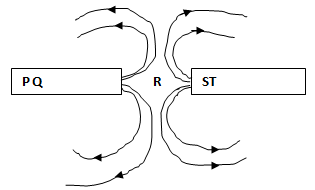
(a) Name parts labeled P, Q, R, S and T
(i) P is………………………………… (ii) Q is……………………………………...
(iii) S is ………………………………. (iv) T is …………………………………….
(v) R is ………………………………..
(b) Define the following terms
(i) Magnetic field ………………………………………………………………………….
……………………………………………………………………………………………...
(ii) Demagnetization……………………………………………………………………….
……………………………………………………………………………………………..
(c) Mention three methods that you can use so as to change a piece of steel and become a magnet
(i) ………………………………………..(ii)…………..………………………………..
(iii) ……………………………………………
5(a) Distinguish between speed and velocity ………………………………………………………………………………………………………………………………………………………………………………………………………………………………………………………………………………………………………………………
(b) An object starts from rest to a velocity of 20m/s for 5 seconds; it maintains this speed for 20seconds before applying brakes and come to rest after 10seconds
(i) Sketch the velocity time graph of this motion
From the graph above, find
(ii) Acceleration
………………………………………………………………………………………………………………………………………………………………………………………………………………………………………………………………………………………………………………………………………………………………………………………………………………………………
(iii) Deceleration
………………………………………………………………………………………………………………………………………………………………………………………………………………………………………………………………………………………………………………………………………………………………………………………………………………………………
(iv) Distance covered by whole motion
………………………………………………………………………………………………………………………………………………………………………………………………………………………………………………………………………………………………………………………………………………………………………………………………………………………………
(v) Average speed of this motion ……………………………………………………………………………………………………………………………………………………………………………………………………………………………………………………………………………………………………………………………………………………………………………………………………………………………...
(c) Define the term “Uniform acceleration ………………………………………………………………………………………………………………………………………………………………………………………………………………
6(a) (i) State the “law of floatation”………………………………………………………………………………………………………………………………………………………………………………………………………………
(ii) State Archimedes principle
....................................................……………………………………………………………...........
………………………………………………………………………………………………………
(b) An aluminium ball weights 6N in air, 4N when immersed in water and 3N when immersed in honey. Calculate;
(i) Up thrust of honey on the ball
………………………………………………………………………………………………………………………………………………………………………………………………………………………………………………………………………………………………………………………
(ii) Relative density of aluminum ball.
………………………………………………………………………………………………………………………………………………………………………………………………………………………………………………………………………………………………………………………………………………………………………………………………………………………………
(iii) Relative density of honey
………………………………………………………………………………………………………………………………………………………………………………………………………………………………………………………………………………………………………………………………………………………………………………………………………………………………
(iv) Density of honey in kg/m3
………………………………………………………………………………………………………………………………………………………………………………………………………………………………………………………………………………………………………………………………………………………………………………………………………………………………………………………………………………………………………………………………………
(c) Why is a hydrometer graduated with minimum reading at the bottom?
………………………………………………………………………………………………………………………………………………………………………………………………………………
7(a) Define the following terms
(i) Machine ……………………………………………………………………………………………………………………………………………………………………………………………………………… (ii) Mechanical advantage ………………………………………………………………………………………………………………………………………………………………………………………………………………(iii) Velocity ratio ……………………………………………………………………………………………………………………………………………………………………………………………………………...(b) Draw a pulley system with velocity ratio (VR) 5
(c) The pitch (P) of a screw jack is 2.5mm. An arm of 56cm long is used to lift a car of mass 792kg if the efficiency of the screw jack is 25%. Find
(i) Velocity ratio ………………………………………………………………………………………………………………………………………………………………………………..………………..…………… (ii) Effort to be applied at the end
………………………………………………………………………………………………………………………………………………………………………………………………………………
8(a) (i) define the term pressure and state its SI unit
………………………………………………………………………………………………………………………………………………………………………………………………………………
(ii) Why are dams constructed thicker at the bottom than at the top?
………………………………………………………………………………………………………………………………………………………………………………………………………………
(b) Mention five (5) sustainable energy sources
(i) ………………………………………………………………………………………
(ii)……………………………………………………………………………………...
(iii)…………………………………………………………………………………….
(iv) ……………………………………………………………………………………
(v) ……………………………………………………………………………………..
(c) Explain why mercury is preferred more as thermometer liquid than alcohol (outline three reasons)
(i)………………………………………………………………………………………
(ii)…………………………………………………………………………………….
(iii)…………………………………………………………………………………….
9. (a) Define the following terms
(i) Inertia
……………………………………………………………………………………………… ………………………………………………………………………………………………
(ii) Momentum
……………………………………………………………………………………………… ………………………………………………………………………………………………
(iii) Impulse
………………………………………………………………………………………………(b) State Newton’s second law of motion
……………………………………………………………………………………………… ………………………………………………………………………………………………
(ii) State the following
1st Equation of motion ……………………………………………………………………
2nd equation of motion ……………………………………………………………………
3rd equation of motion ……………………………………………………………………
(c) A ball “A” of mass 100g moving with a velocity of 5m/s makes a head on collision with a ball “B” of mass 200g moving with velocity of 2m/s in opposite direction. If A and B stick together after collision, calculate their common velocity “V” in the A.
………………………………………………………………………………………………………………………………………………………………………………………………………………………………………………………………………………………………………………………………………………………………………………………………………………………………………………………………………………………………………………………………………………………………………………………………………………………………………………………………………………………………………………………………………………………………………………………………………………………………………………………………………………………………………………………………………………………………………………………………………………………………………………………………………………………………………………………………………………………………………………………
SECTION C (15 MARKS)
Answer all questions from this section
10 (a ) Sketch the electrical symbol for each of the following devices.
(i) Voltmeter
(ii) Switch
(iii) Battery
(iv) Variable resistor
(b) Calculate the effective resistance to the current flowing when resistors 4Ω, 2Ω and 5Ω are connected in
(i) Series
……………………………………………………………………………………………………………………………………………………………………………………………………………………………………………………………………………………………………………………………………………………………………………………………………………………………………………………………………………………………………………………………………....
(ii) Parallel
………………………………………………………………………………………………………………………………………………………………………………………………………………………………………………………………………………………………………………………………………………………………………………………………………………………………………………………………………………………………………………………………………………………………………………………………………………………………………………………………………………………………………………………………………………………………………………………………………………………………………………………………
(c) Find the effective capacitance in the connection below.

………………………………………………………………………………………………………………………………………………………………………………………………………………………………………………………………………………………………………………………………………………………………………………………………………………………………………………………………………………………………………………………………………………………………………………………………………………………………………………………………………………………………………………………………………………………………………………………………………………………………………………………………………………………………………………………………………………………………………………………………………………………………………………………………………………………………………………………………………………………………………………………
Page 1 of 11
LEARNINGHUBTZ.CO.TZFORM TWO PHYSICS MODAL SERIES 23
LEARNING HUB TANZANIA
PHYSICS EXAMINATION FORM TWO
MODEL EXAMINATIONS.
NAME………………………………………..CLASS……………………………………………….TIME: 2:30HRS
INSTRUCTIONS:-
- This paper consists of section A, B and C
- Answer all questions
- All answers must be clearly, neatly and systematically written, dirty work will not be marked
- The following constants may be used: Acceleration due to gravity g = 10m/s2, Density of Hg = 13.6g/cm3 or 13600 kg/m3, Density of water = 1g/cm3 or 1000 kg/m3
SECTION A.
- Choose the most correct answer and write its letter in the box provided at each item number.
(i) Physics is applied in many fields such as
- Energy and books
- Matter and examination
- Industry and medicine
- Garage and school
(ii) In a block and tackle pulley system, the velocity ratio is given by
- Number of strings in the pulley
- Effort arm divide by load arm
- Distance moved by load divide by distance moved by effort Number of pulleys in the system
(iii) The following instruments are used to measure length except
- Vernier caliper
- Spring balance
- Meter ruler
- Tape measure
(iv) The boiling point of water at Dar-es-salaam is 100![]() the boiling point of water at mount Kilimanjaro is
the boiling point of water at mount Kilimanjaro is
- Above 100

- 100

- Less than 100

- None of the above.
(v) Mirrors are able to form images because
- Magnification
- The reflection of light
- The regular reflection of light
- The irregular reflection of light
(vi) If a force of 10N, acting continuously increasing the kinetic energy of object from 20J to 60J. the distance moved by the object is then
- 6m
- 2m
- 4m
- 600m
(vii) The basic physical quantities are
- Volume, mass and pressure
- Length, time and mass
- Mass, length and volume
- Pressure, density and time
(viii) Some of the following reasons show that water is not suitable for the use in the construction of liquid in bulb thermometer except
- Water is a volatile liquid
- Water is poor conductor of heat
- Water has a large heat capacity
- Its expansion is not linear
(ix) A body weight 11.8N when totally immersed in liquid if the weight of displaced is 4.2N the weight of the body in air is
- 16N
- 7.6N
- 2.8N
- 49.57N
(x) A materia which is not good insulator is
- Wax
- Brass
- Clay
- Cotton
(xi) ___________ is used to measure electric current
- Switch
- Ammeter
- Voltmeter
- Galvanometer
SECTION B.
- Match the items in list A with response to the alternatives in list B by writing the letter of the correct response beside the item number.
List A.
(i) Collision
(ii) Lunar eclipse
(iii) Insulator
(iv) Load
(v) Cohesive
List B.
- Volume
- Moon between sun and earth
- Newton’s second law of motion
- Relative density
- Earth between the sun and moon
- The ability of the molecules of the same substances to attract each other
- Moving charges
- Stationery charges
- Newton’s third law of motion
- The ability of molecules of different substances to attract each other
- The force applied in a moving a load
- Distances moved in a particular direction
- Rubber
- Iron
- Unlike poles
- Mass moved by a machine
- Like poles
- The rate of distance moved with time in a specific direction
- N.S
- Kg/s2
| i | ii | iii | iv | v | vi | vii | viii | ix | x |
|
|
|
|
|
|
|
|
|
|
|
SECTION B 60 Marks
- Complete each of the following statements by writing the correct answer in the space provided
- Mass, length and __________________ are three fundamental quantities of measurement in physics
- State two applications of density in daily life
(i) ______________________________________________________
(ii) ______________________________________________________
- Magnets are named according to their shapes. Mention three types of magnets
- When taking measurement there may be some error in the reading mention three common examples.
- The angle between true north and the compass needle directions is known as _______________________ (10marks)
- (a) A body weight 1.5N in air and when immersed in water it weights 1.1N its apparent weight is _________________________
(b) Three types of inertial are _________________________,____________________,______________________
(c) The formation of shadow is an evidence that light travels in (10marks)
- (a) What is a sustainable source of energy
(b) Mention any four suitable source of energy
( c ) Give benefits of using Biogas as a source of fuel (10marks)
- (a) What is a magnet?
(b) State the basic law of magnetism
(c) Given the figure below
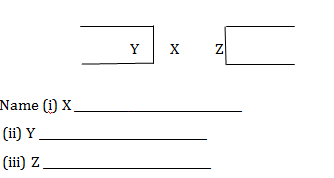
(10marks)
- (a) The principle of moment
(b) State two conditions for the body to be in equilibrium
(c) From the figure below determine F1
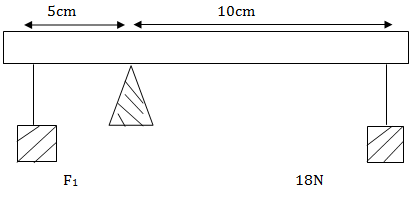
(10marks)
- (a) Give the different between acceleration and deceleration
(b) A car is initially travelling at 10m/s accelerates uniformly for 10sec to a velocity of 25m/s then it maintained a steady for 5sec before decelerating uniformly to rest in 4sec.
(i) Draw velocity time graph for this motion
(ii) Find acceleration and deceleration
(iii) Calculate the total distance travelled by the car (10 marks)
SECTION C 25 marks
- (a) State application of density in daily life.
(b) An irregular solid P has a mass of 50g when it is totally immersed in water of volume 60cm3 the final volume of water was read as 70cm3. Calculate
(i) The velocity of solid
(ii) The density of a solid P
(iii) The relative density of solid P.
- (a) Define “watt”
(b) A body weighing 60kg used 30sec to run upstairs if the power generated by the boy was 60w and each stair is 0.5m high. Find the number of stairs.
11. (a) Define pressure
(b) What is the S.I unit of pressure?
(c) A hydraulic brake has a force of 500N applied to a piston whose area is 5cm2.
(i) What is the pressure transmitted throughout the liquid?
(ii) If the other piston has an area of 20cm2, what is the force exerted on it?
LEARNINGHUBTZ.CO.TZ Page 1
LEARNINGHUBTZ.CO.TZFORM TWO PHYSICS MODAL SERIES 15
LEARNING HUB TANZANIA
PHYSICS EXAMINATION FORM TWO
MODEL EXAMINATIONS.
NAME………………………………………..CLASS……………………………………………….TIME: 2:30HRS
Instructions:
(i) This paper consists at sections A,B and C
(ii) Answer all questions in all sections.
(iii) Whenever necessary use the following constants.
- Density of water =1g/cm3 or 1000kg/m3
- Density of mercury = 13.6g/cm3 or 13600kg/m3
- Acceleration due to gravity (g) = 10m/s2
SECTION A (20) MARKS
- Write the letter of the correct answer in the box provide for each of the following items.
(i) The relation of physics and chemistry is in making.
- Algebra, trigonometry and chemical change
- Insect killers, perfume and fertilizers
- Photosynethis and food
- Rain gauge, wind vane and thermometer.
(ii) Which of the following instrument groups is used to measure basic fundamental quantities.
- Beam balance, stop watch, vernier caliper
- Chemical balance, stop watch, vernier caliper
- Measuring cylinder, beam balance and water rule
- Spring balance, stop watch and micrometer screw gauge.
(iii) Swelling of soaked beans in water is the demonstration of:-
- Capillary
- Diffusion
- Osmosis
- Viscosity
(iv) Which is the following is property at a solid state
- Inter- particle distance in large
- Particle in are closely packed together
- Particles move randomly
- Particle are not closely packed together.
(v) An instrument which is used to observe objects around obstacle is called.
- Microscope
- Periscope
- Plane glass
- Telescope
(vi) The relationship between pressure and area is that on:-
- Changing area, nothing happens
- Decreasing area, pressure decreases
- Decreasing pressure, volume increases
- Increasing area, pressure decrease
(vii) A piece of metal of metal with a volume of 0.00012m3 has a mass of 0.12kg. The density of metal will be:-
- 100kg/m3
- 1000kg/m3
- 10,000kg/m3
- 1,000,000kg/m3
(viii) If students gets an electric shock and fall down unconscious in a physics laboratory which of the following would you do first to help the victim?
- Administer breathing exercise
- Call a medical doctor immediately
- Call other student to surround the victim
- Call a physics teacher to give the victim machine
(ix) The sun is an example of luminous body because it:-
- Is a big star
- Is made of God
- Produced its own of light
- Reflects light from the earth
(x) A smell of rotten body can be felt through the process of
- Diffusion
- Evaporating
- Osmosis
- Transpiration
(xi) A measuring cylinder contains liquid to a level x. An object of volume Z is totally immersed in the liquid contained in the cylinder. The new reading of the level of the liquid will be:-
- X
- X-Z
- X+Z
- Z-X
(xii) An object with low centre of gravity and wide base is:-
- Neutral
- Stable
- Unequilibrial
- Unstable
(xiii) A ball of mass 0.6kg is kicked vertically up to a height of 6m. the potential energy acquired by the ball is
- 0.36J
- 3.6J
- 360J
(xiv) From Archimedes principle, the upthrust acting on a body is equal to the :-
- Apparent loss loss in weight
- Apparent weight
- Weight of the body in air
- Weight of the water displaced.
(xv) The acceleration of a body of mass 30kg when a constant force of 150N is applied on it will be.
- 0.5m/s2
- 0.5m/s2
- 5.0m/s2
- 50m/s2
(xvi) The material will pass light partially is well known as:-
- Glass material
- Transparent material
- Tinted material
- Translucent material
(xvii) The 120m temperature recorded at KIA status
- 30oC
- 30 F
- 273K
- 960F
(xviii) The volume of a piece of metal with a mass of 150g and density of 0.03g/cm3 is :-
- 5 x 10-5 cm3
- 5 x 101 cm3
- 5 x 102 cm3
- 5 x 103 cm3
(xix) The force exerted by a pressure of 20Pa acting over and area of 2m2 is :-
- 10N
- 18N
- 22N
- 40N
| List A | i | ii | iii | iv | v | vi | vii | viii | ix | x |
| List B |
|
|
|
|
|
|
|
|
|
|
| xi | xii | xiii | xiv | xv | xvi | xvii | xviii | xix | xx |
|
|
|
|
|
|
|
|
|
|
|
SECTION B 40 MARKS
- Match the item list A with the correct response from list B
| List a | List b |
| (i) Attractive force between molecule of the same substance (ii) Bodies that give out light (iii) Device used to put on or of current (iv) Used to measure body temperature (v) Product of mass and velocity (vi) Measure weight of a body (vii) Friction between lagers of fluid (viii) Distance travelled per unit time |
|
| List A | i | ii | iii | iv | v | vi | vii | viii |
| List B |
|
|
|
|
|
|
|
|
- Complete each of the following statements by writing the correct answer in the space provide.
(i) In the velocity – time graph, the slope represent…………………………
(ii) The weight at the body when in water is known as………………………
(iii) The type of force which cause the size and volume of an object to decrease known as……
(iv) The tendency of an object to remain on the surface of a fluid due to the force existed by fluid is called………………………………
- (a) Define the term pressure.
(b) A rectangular object whose dimensions are 1.4m x 0.1m x 2.0m has a density of 20kg/m3. Calculate the minimum pressure when placed on a table.
- (a) Define each of the following terms as applied in physics.
(i) Volume
(ii) Moment of force
(b) An object of 100kg is lifted to a height of 5m above the ground in 3seconds. Calculate its
(i) Work done
(ii) Power
- (a) State Archimedes principle
(b) A body weighs 12N when on air and 10N when completely immersed in water. Calculate the:-
(i) Upthrust
(ii) Relative density of the object.
SECTION C (40 MARKS)
- (a) (i) State principle of moment
(ii)Define the term centre of gravity
(b) A uniform half – metre rule is freely pivoted at 15cm mark and it balances horizontally when a body of mass of mass of 40g is hung form 2cm mark.
(i) Draw the diagram to illustrate the forces
(ii) Calculate the mass of the rule.
- (a) Draw a beam of light showing:-
(i) Convergent rays
(ii) Divergent rays
(iii) Parallel rays
(b) Mention four properties of image formed by plane mirror.
- An object starts from rest and accelerate to a velocity of 20m/s for 5seconds. It then maintain this speed for 20seconds before applying brakes and comes to rest after 10 seconds.
(a) Sketch the velocity – time graph for this motion
(b) From the graph drawn in part (a) above find (i) Acelleration (ii) Deceleration.
(c) Calculate the distance travelled.
- (a) State law of floatation
(b) A body weighs 10N in air and 8N when completely immersed in a liquid of density 0.8g/cm3 find
(i) The volume of the liquid displaced
(ii) The density of the body.
LEARNINGHUBTZ.CO.TZ Page 1
LEARNINGHUBTZ.CO.TZFORM TWO PHYSICS MODAL SERIES 14
LEARNING HUB.TZ
PHYSICS EXAMINATION FORM TWO
ANNUAL EXAMINATIONS.
NAME………………………………………..CLASS……………………………………………….TIME: 2:30HRS
INSTRUCTIONS:-
SECTION A :
- Answer ALL questions in this section by writing the letter of the correct answer/ beside the equation number in your answer book.
- Physics is defined as the study of;
- The relationship between life and work
- The relationship between life and matter
- The relationship between living and non-living things.
- The relationship between matter and energy
- In thermometry, the ice point and steam point are respectively reffered to as;
- Minimum and maximum points
- Freezing and Boiling points
- Lower and upper fixed points
- Standard and fundamental points
- The presence of positive electric charge in a body can be detected by using;
- An electroscope
- Voltmeter
- A compass
- Hydrometer
- One of the following is the property of the image formed in a plane mirror;
- Smaller than the object
- Larger than the object
- Real image
- Virtual image
- The thermometric liquid used to measure low temperature is;
- Alcohol B. Mercury C. Water D. Coloured alcohol
- A piece of metal of volume 0.24cm3 and mass 0.72g has a relative density of;
- 3g/cm3 B. 3kg/m3 C. 0.3 D. 3
- Pressure in liquid depends on;
- Area and Volume
- Volume and density
- Depth and volume
- Density and Depth
- When a body floats in a liquid;
- Its weight is less than the upthrust on it
- Its weight is greater than the upthrust on it
- Its weight is equal to the upthrust on it
- Its volume is equal to the volume of the liquid displaced
- A temperature of 100°F is equal to;
- 33.3°C B. 47.8°C C. 73.3°C D. 37.8°C
- A stone of mass 500g is lifted through a height of 2m. The potential energy gained by the stone is;
- 100J B. 70J C. 40J D. 10J
- When charging an object by friction, the particles which are transferred are;
- Elections B. Protons C. Newtons D. Electrons and protons
- 1 litre is equal to;
- 500cm3 B. 2m3 C. 1000cm3 D. 1m3
- According to the scientific definition of work, pushing a rock does not accomplish work unless there is;
- A net force
- Movement in the same direction as the direction of force
- An opposite force
- Movement
- The rate at which energy is transferred is called;
- Watt B. Power C. Joule per second D. Workdone
- The normal temperature of a human being is;
- 13.8°F B. 66.4°F C. 98.4°F D. 38°F
- A body which gains elections become;
- Negatively charged
- Positively charged
- Electrified
- Both A and B are correct
- The surface tension of a liquid is due to;
- Molecules of its surface
- Elastic skin which covers the surface of the liquid
- Cohesive force between its surface molecules
- Adhesive force between different molecules
- The temperature of Dodoma town was 40°C. This is equivalent to;
- 313 Kelvin B. 240 Kelvin C. 110 Kelvin D. 120 Kelvin
- When five hazard from an electrical fault erupts in a house;
- Cut off all connecting wires
- Switch off the main switch
- Break the main switch
- Switch off the switch socket
- The S.I. Unit of temperature is;
- Centigrade B. Second C. Kelvin D. Fahrenheit
- Match the following items by writing the letter of the correct meaning from List B against the number of item in list A.
| LIST A | LIST B |
|
|
SECTION B
- Answer the following questions by filling in the blanks with the correct answers;
- Temperature is the degree of …………………………………… or ……………………………………. of body.
- The steam point on Celsius scale is ……………………………….. while on the Fahrenheit scale is ……………………………………………
- The main difference between clinical thermometer and other types of thermometer is that clinical thermometer has. …………………………….
- The two limitations of clinical thermometer are ……………………………….. and ……………………………
- Two precautions to considered during the use of clinical thermometer includes ……………………………………………….. and ………………………………………
- Some of the physical properties, that change with temperature are ………………………………………. and ……………………………………..
- Three types of thermometers are ……………………………….., …………………………………………….. and …………………………………………
- Two reasons why mercury is preferred to as a thermometric liquid are ………………………………… and ………………………………………..
- Conversion between the three temperature scales, Celsius, Kelvin and Fahrenheit are done by conversion equations which are ………………………………………., ……………………………………………… and ………………………………………………………………….
- A liquid-in-glass thermometer depends on the ……………………………………………… of the liquid vary with temperature.
- List two importances of water energy
(a) …………………………………………………………………………………………….
(b) …………………………………………………………………………………………….
- The two applications of water energy are;
(a) ………………………………………………………………………………………………
(b) ………………………………………………………………………………………………
- The two applications of solar energy are;
(a) ……………………………………………………………………………………………..
(b) ……………………………………………………………………………………………..
- In the solar panel, the pipes are bent or coiled so as to increase the ……………………………… over which the radiant every can act.
- Three areas in East Africa which are geologically well – structured to produce efficient geothermal system are ………………………………………., ………………………………………………. and ………………………………………………..
- The number of images formed by multiple mirrors relates with the angle between two mirrors by the formula …………………………………………
- The S.I. unit of capacitance of a capacitor is …………………………………
- The equation which relates the three factors that affect the capacitance of a capacitor is given by ……………………………………….
- ………………………………………… is the zigzag path followed by electrons from the negative clouds across the air towards the positive cloud.
- When a charged electroscope is touched by a finger it. ………………………….. This is called ……………………………………………………..
- (a) Define the following terms;
- Elasticity ……………………………………………………………………………………………………………………………………………………………………………………………………………………………………………………………………………………
- Viscosity …………………………………………………………………………………………………………………………………………………………………………………………………………………………………………………………………………………….
- Surface tension ……………………………………………………………………………………………………………………………………………………………………………………………………………………………………………………………………………………..
- Capillarity …………………………………………………………………………………………………………………………………………………………………………………………………………………………………………………………………………………….
(b) The tip of a needle has a cross sectional area of (1 x 102)m2. If a doctor applies a force of 20N
to a syringe that connected to the needle, what is the pressure exerted at the tip of the needle?
- (a) Define the following terms;
- Diffusion ……………………………………………………………………………………………………………………………………………………………………………………………………………………………………………………………………………………
- Osmosis ……………………………………………………………………………………………………………………………………………………………………………………………………………………………………………………………………………………
- Pressure ……………………………………………………………………………………………………………………………………………………………………………………………………………………………………………………………………………………
- Mass …………………………………………………………………………………………………………………………………………………………………………………………………………………………………………………………………………………….
- (a) Define the following terms;
- Temperature ……………………………………………………………………………………………………………………………………………………………………………………………………………………………………………………………………………………
- Constriction ……………………………………………………………………………………………………………………………………………………………………………………………………………………………………………………………………………………
- Meniscus ……………………………………………………………………………………………………………………………………………………………………………………………………………………………………………………………………………………
- Kelvin ……………………………………………………………………………………………………………………………………………………………………………………………………………………………………………………………………………………
- Thermometric property …………………………………………………………………………………………………………………………………………………………………………………………………………………………………………………………………………………..
(b) State four (4) reasons, why water is unsuitable as a thermometric liquid. ……………………………………………………………………………………………………………………………………………………………………………………………………………………………………………………………………………………………………………………………………………………………………………………………………………………………………………………………………………………………………………………………………………………………………………………………..
(c) Define the following terms;
- Fixed points ……………………………………………………………………………………………………………………………………………………………………………………………………………………………………………………………………………….
- Lower fixed point ………………………………………………………………………………………………………………………………………………………………………………………………………………………………………………………………………………
- Upper fixed point ……………………………………………………………………………………………………………………………………………………………………………………………………………………………………………………………………………………………………………………………………………………………………………………………………………………….
- Fundamental interval of a thermometer ………………………………………………………………………………………………………………………………………………………………………………………………………………………………………………………………………………………………………………………………………………………………………………………………………………………
(d) Explain briefly why clinical thermometer is not sterilized by using water? ………………………………………………………………………………………………………………………………………………………………………………………………………………………………………………………………………………………………………………………………………………………………………………………………………………………………………………………………………………………………………………………………………………………………………………………………………………………………………………………………………………………………………………………………….
- (a) State 3 factors that determine the capacitance of a capacitor, and write the equation which connect the three factors. ………………………………………………………………………………………………………………………………………………………………………………………………………………………………………………………………………………………………………………………………………
(b) List down four types of capacitor
…………………………………………………………………………………………………………..
……………………………………………………………………………………………………………
…………………………………………………………………………………………………………….
…………………………………………………………………………………………………………….
(c) Three capacitors of capacitance 2µF, 4µF and 6µF are connected in the circuit. Calculate the total
capacitance when the capacitors are connected in;
(i) Series …………………………………………………………………………………………………………………………………………………………………………………………………………………………………………………………………………………………………………………………………………………………………………………………………………………..
(ii) Parallel ……………………………………………………………………………………………………………………………………………………………………………………………………………………………………………………………………………………………………………………………………………………………………………………………………………………
(d) In the verification of Ohm’s law the following circuit was used during the experiment;
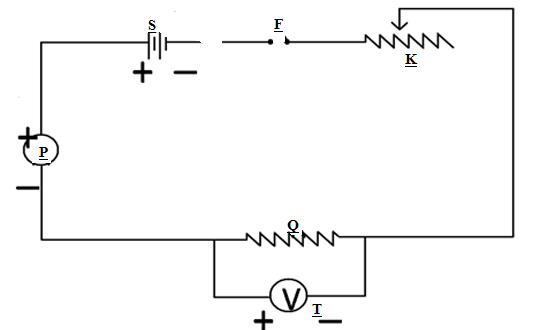
(i) P: represents ……………………………………………………….
(ii) Q: represents ……………………………………………………….
(iii) T: represents ………………………………………………………..
(iv) F: represents ……………………………………………………….
(v) S: represents ……………………………………………………….
(vi) K: represents ………………………………………………………..
- (a) Define Ohm’s law ………………………………………………………………………………………………………………………………………………………………………………………………………………………………………………………………………………………………
(b) What would be the effect on the resistance of a conductor if;
- Its length was increased? ………………………………………………………………………………………………………………………………………………………………………………………………………………………………………………………………
- Its temperature was increased? ……………………………………………………………………………………………………………………………………………………………………………………………………………………………………………………………..
- Its cross – sectional area was reduced? ………………………………………………………………………………………………………………………………………………………………………………………………………………………………………………………………
(c) In tabular form write down five (5) differences between mass and weight
| Mass | Weight |
| | i. |
| | ii. |
| | iii. |
| | iv. |
| | v. |
- (a) Consider the circuit below;
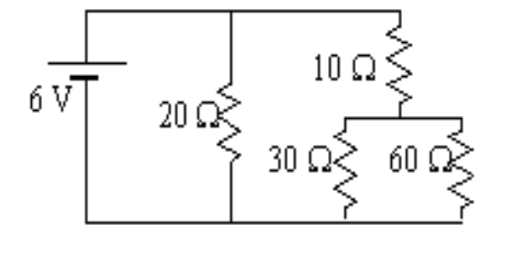
(i) Find the equivalent resistance.
(ii) Determine the current in the circuit.
(iii) Determine the current across 4![]() resistor.
resistor.
(b) Draw a well labelled diagram of a gold leaf electroscope;
(c) State four (4) functions of a gold leaf electroscope;
(i) …………………………………………………………………………………………………………..
(ii) …………………………………………………………………………………………………………..
(iii) ………………………………………………………………………………………………………..
(iv) …………………………………………………………………………………………………………..
- (a) What is wind mill? ………………………………………………………………………………………………………………………………………………………………………………………………………………………………………………………………………………………………………………………………………………
(b) Mention three (3) disadvantages of energy caused by wind.
(i) …………………………………………………………………………………………………………
(ii) …………………………………………………………………………………………………………
(iii) ………………………………………………………………………………………………………
(c) Does wind itself posses energy? Explain ……………………………………………………………………………………………………………………………………………………………………………………………………………………………………………………………………………………………………………………………………………………………………………………………………………………………………………………………………………………………………………………………………………………………………………………………………………………………………………………………………………………………………………………………………………………………………….
(d) State four examples of sustainable energy sources
(i) ……………………………………………………………………………………………
(ii) ……………………………………………………………………………………………
(iii) ……………………………………………………………………………………………….
(iv) ………………………………………………………………………………………………..
10. (e) Name the circuit devices represented by the following circuit symbols and state their uses;
| Circuit symbol | Circuit Device | Uses |
| i. |
|
|
| ii. |
|
|
| iii. |
|
|
| iv. |
|
|
| v. |
|
|
| vi. |
|
|
| vii. |
|
|
| viii. |
|
|
| ix. |
|
|
| x. |
|
|
LEARNINGHUBTZ.CO.TZ Page 1
LEARNINGHUBTZ.CO.TZFORM TWO PHYSICS MODAL SERIES 11
LEARNING HUB TANZANIA
PHYSICS EXAMINATION FORM TWO
MODEL EXAMINATIONS.
NAME………………………………………..CLASS……………………………………….TIME: 2:30HRS
INSTRUCTIONS:
- This paper consists of section A,B and C
- Answer all questions in each section.
- Whenever necessary use the following constants;-
-Acceleration due to gravity g=10m/s2 or g=10N/kg
-Density of water =1000kg/m3 or 1g/cm3
SECTION A (20MARKS)
- For each of the following items, choose the correct answer.
- The ratio of the density of substance to the density of pure water is:-
a) Mass per unit volume
b) Relative density of water
c) Relative density of substance
d) Upthrust on pure water
- The area under the velocity time graph is:-
a) decelleration
b) speed
c) displacement
d) acceleration
- A car with a velocity of 30m/s is uniformly retarded and brought to rest after 10 seconds, therefore its acceleration is:-
a) 3m/s2
b) -3m/s2
c) 300m/s2
d) 0.3m/s2
- Sharp knife cut easily than blunt one because:
a) The blunt edge exert high pressure due to large surface area
b) The sharp edge exert high pressure due to small surface area
c) The blunt edge exert low pressure due to small surface area
d) The sharp edge exert low pressure due to large surface area.
- The following is not an example of force
a) gravity
b) torsional
c) repulsion
d) newton
- A wheel barrow is a …………………..class lever
a) first
b) third
c) second
d) fourth
- An object weighs 4.8N in air, it its upthrust is 2.3 N, its weight when immersed in water will be
a) 2.3N
b) 7.1N
c) 2.5N
d) 2.5
- …………………the number of times a substance is denser than a given density of water.
a) density
b) measurement
c) relative density
d) volume of substance
- Pressure in liquid depends on the:-
a) Density of mercury
b) Depth of liquid
c) Height of water
d) Density of water
- The parallel mirror in periscope are filled at:-
a) 30o
b) 45o
c) 0o
d) 90o
| Item | | | | | | | | | | |
| Ans |
|
|
|
|
|
|
|
|
|
|
- Match the items in list A with the correct response in list B by writing its letter below the number of the corresponding item
| LIST A | LIST B |
| a) change of momentum b) velocity c) high pressure d) low pressure e) S.I unit of energy f) S.I unit of power g) Velocity ratio (V.R) h) Reaction and action are equal and opposite i) acceleration j) force
|
- Complete the following statements by filling in the blanks with the correct answers
- An instrument used to measure mass of a substance is known as ……………………….
- Work has the same unit as …………………….
- ……………………….is an instrument used to detect charge.
- The tendency of liquid to raise or fall in a narrow tube is called…………………………..
- Four types of simple machine are …………………..
- …………………..
- ……………………
- ……………………… (10marks)
- (a)(i) Define temperature and state its SI unit.
(ii) Explain briefly why the clinical thermometer has a very short range of about 35oC to 43oC
(b)Give five reasons why water is not a good thermometer liquid. (10marks)
- (a)Define the following terms as used in physics (i) work (ii) energy (iii) power
(b)A man lifts a load of 30kg through a height of 5m in 10 seconds. Calculate the (i) work done (ii)power developed by the man. (10marks)
6. (a) Distinguish between umbra and penumbra shadows
(b) State the properties of the images formed by plane mirrors (10marks)
7. Define the centre of gravity of a body. Explain why racing cars should have wide wheel tracks.
(10marks)
8. (a) Explain what is a gold leaf electroscope
(b) State two uses of the gold leaf electroscope.
(c) Define the terms capacitor and capacitance
(d) Calculate the capacitance of a capacitor whose electric potential is 3V and charge is 0.2![]() C. (10marks)
C. (10marks)
SECTION C (25MARKS)
9. (a)(i)Define momentum and state its SI unit.
(ii) State the law of conservation of linear momentum.
(b)(i)Differentiate between elastic and inelastic collision.
(ii)An arrow of mass 0.1kg is shot into a block of wood of mass 0.4kg lying at rest on smooth surface of an ice rink. If at the moment of impact the arrow were moving horizontally at 15m/s. calculate the common velocity after the impact (collision)
10. (a) State newton’s laws of motion.
(b) List three (3) parts of lever.
11. (a) State the principle of moments
(b) State the two conditions of a body acted by parallel forces to remain at equilibrium
(c) Calculate w and R if the system below is at equilibrium
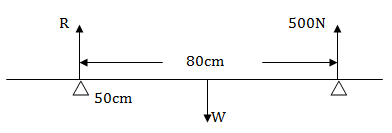
LEARNINGHUBTZ.CO.TZ Page 1
LEARNINGHUBTZ.CO.TZFORM TWO PHYSICS MODAL SERIES 10
 For Call,Sms&WhatsApp: 255769929722 / 255754805256
For Call,Sms&WhatsApp: 255769929722 / 255754805256
 For Call,Sms&WhatsApp: 255769929722 / 255754805256
For Call,Sms&WhatsApp: 255769929722 / 255754805256






